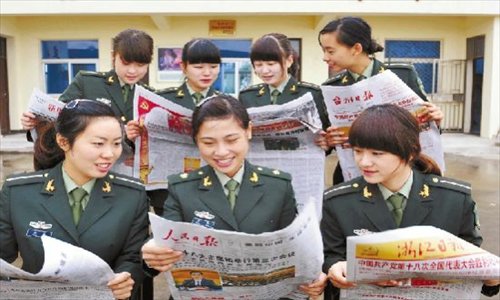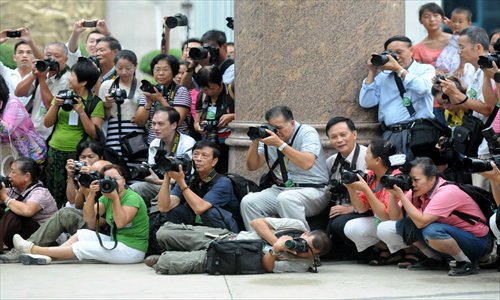HOME >> CHINA
Staging the news
By Wen Ya Source:Global Times Published: 2012-11-23 1:00:05

The staged photo which prompted outrage Photo: courtesy of People's Online

The photo shows seven smiling women from the Leigongshan military reserves in Shitang township, in the province's city of Wenling, reading three different newspapers together for updates on the 18th National Congress of the Communist Party of China.
However, the photo stirred overwhelming criticism online as netizens pointed out that apart from the newspapers' front pages in their hands, the content of the articles was anything but related to the Party congress.
The photo hearkened back to an era when staged photos were the norm, and were even a crucial part of the country's history.
However, the backlash indicates that public attitudes are slowly changing while framed against a complex ethical dilemma for the media.
The public backlash
The group apologized for tarnishing the reputation of the news and "misleading" the public via the photo. The photo center also announced that it had decided to withhold the monthly bonus of Pan Haisong, the department's editor, who had edited the photo, and suspended the photographer's photo release rights for six months.
"This event is a warning to all news photographers," said Yan Zhigang, a professor on news photography at the Journalism School of Fudan University.
"News photos should be based on facts that can't be breached. They can't be orchestrated by photographers, or their credibility will be hurt," he said.
Li Ge, director with the photography department of the People's Daily, told the Global Times that the photo was too artificial.
"The People's Daily hasn't used a photo like this for 20 years," he said Thursday.
If this picture appeared two decades ago, people would never have questioned it, because they had become used to the style of publicity over that period, a photographer from a news agency in Beijing, who asked to remain anonymous, told the Global Times.
"But today, the public's wrath will be incited if the picture exemplifies that archaic mindset," he said.
Zhang Zhi'an, an associate professor with the School of Communication and Design at the Sun Yat-Sen University, said it's common for Chinese newspapers to stage pictures.
"As early as 1942, the then Jiefang Daily needed to create role models in areas controlled by the CPC and has since been followed as a path for Party-backed newspapers," Zhang said.
Zhang added that this was also related to the newspaper's responsibility to spread the Party's policy then.
A staged snapshot of history
Some famous staged pictures of Chinese leaders even positively influenced generations.
One that shows Chairman Mao Zedong playing table tennis in 1962 is an obvious example.
The photo, which was staged by Lü Houmin, a former journalist from the Xinhua News Agency, along with Mao's private doctor, gave the public a deep impression that Mao liked table tennis.
The sport has been popular nationwide since then and many even thought that the chairman played every day.
However, Mao liked reading, swimming and walking more than table tennis, according to Li Mingsheng, the author of a 2003 book about the reporters that surrounded Mao.
The Shanghai-based News Times reported that the shooting process for such pictures, which marked rare successes in the country's news photography history, did not raise controversy.
These pictures reached a climax in the Great Leap Forward (1958-60) and fake news pictures started to emerge in leading State-owned news outlets.
In 1958, Yu Chengjian, a former Xinhua photographer, published a set of pictures on the People's Daily showing that the rice production of Maxihe township in Hubei Province reached 15,000 kilograms per mu (0.067 hectare).
One of them showing four children standing on rice that was said to still be growing is among the most influential staged pictures since 1949, according to the News Times.
Later, Yu said he learned that the scene was staged by farmers who collected ripe rice and piled it up in a very small place.
"At that time, I had no common sense and shot the picture without any investigation. The picture brought disasters to the country and the people and it also gave me a lifelong lesson," Yu later said in a report in the China Journalist magazine in 1987.
Staged pictures are still common. A picture posted on chinamil.com.cn, a military website, showed soldiers that had caught a Hairtail, a sea-bred fish, from a river and a white rabbit in the wild during a drill in the Xinjiang Uyghur Autonomous Region in August.
After online criticism, the website admitted the pictures had been staged.
Changing ideas
In 2008, the Photojournalist Society of China regulated the award requirements for journalism photography, stipulating that staged or modified photos, as well as those with unsuitable captions cannot be accepted.
It also said that pictures about to be awarded should be shown to the public for their opinions, the Guangzhou-based South Metropolis Daily reported.
Currently, almost all journalists agree that news pictures, especially breaking news, shouldn't be staged, Yan said.
"Sometimes, in order to achieve a good photo, the photographer can make suggestions to people, but they can't interrupt their normal life and work," Yan said.
"If some facts are not expressed, captions can be used to provide additional information," he added.

Photographers gather to shoot an event in the Guangxi Zhuang Autonomous Region. Photo: CFP
The photography department of the Hangzhou-based Zhejiang Daily Press Group apologized publicly on November 17 for a staged photo on the front page of its affiliated Today Morning Express, a move experts said marked the first ever apology for a staged photo since the country was founded in 1949. The photo shows seven smiling women from the Leigongshan military reserves in Shitang township, in the province's city of Wenling, reading three different newspapers together for updates on the 18th National Congress of the Communist Party of China.
However, the photo stirred overwhelming criticism online as netizens pointed out that apart from the newspapers' front pages in their hands, the content of the articles was anything but related to the Party congress.
The photo hearkened back to an era when staged photos were the norm, and were even a crucial part of the country's history.
However, the backlash indicates that public attitudes are slowly changing while framed against a complex ethical dilemma for the media.
The public backlash
The group apologized for tarnishing the reputation of the news and "misleading" the public via the photo. The photo center also announced that it had decided to withhold the monthly bonus of Pan Haisong, the department's editor, who had edited the photo, and suspended the photographer's photo release rights for six months.
"This event is a warning to all news photographers," said Yan Zhigang, a professor on news photography at the Journalism School of Fudan University.
"News photos should be based on facts that can't be breached. They can't be orchestrated by photographers, or their credibility will be hurt," he said.
Li Ge, director with the photography department of the People's Daily, told the Global Times that the photo was too artificial.
"The People's Daily hasn't used a photo like this for 20 years," he said Thursday.
If this picture appeared two decades ago, people would never have questioned it, because they had become used to the style of publicity over that period, a photographer from a news agency in Beijing, who asked to remain anonymous, told the Global Times.
"But today, the public's wrath will be incited if the picture exemplifies that archaic mindset," he said.
Zhang Zhi'an, an associate professor with the School of Communication and Design at the Sun Yat-Sen University, said it's common for Chinese newspapers to stage pictures.
"As early as 1942, the then Jiefang Daily needed to create role models in areas controlled by the CPC and has since been followed as a path for Party-backed newspapers," Zhang said.
Zhang added that this was also related to the newspaper's responsibility to spread the Party's policy then.
A staged snapshot of history
Some famous staged pictures of Chinese leaders even positively influenced generations.
One that shows Chairman Mao Zedong playing table tennis in 1962 is an obvious example.
The photo, which was staged by Lü Houmin, a former journalist from the Xinhua News Agency, along with Mao's private doctor, gave the public a deep impression that Mao liked table tennis.
The sport has been popular nationwide since then and many even thought that the chairman played every day.
However, Mao liked reading, swimming and walking more than table tennis, according to Li Mingsheng, the author of a 2003 book about the reporters that surrounded Mao.
The Shanghai-based News Times reported that the shooting process for such pictures, which marked rare successes in the country's news photography history, did not raise controversy.
These pictures reached a climax in the Great Leap Forward (1958-60) and fake news pictures started to emerge in leading State-owned news outlets.
In 1958, Yu Chengjian, a former Xinhua photographer, published a set of pictures on the People's Daily showing that the rice production of Maxihe township in Hubei Province reached 15,000 kilograms per mu (0.067 hectare).
One of them showing four children standing on rice that was said to still be growing is among the most influential staged pictures since 1949, according to the News Times.
Later, Yu said he learned that the scene was staged by farmers who collected ripe rice and piled it up in a very small place.
"At that time, I had no common sense and shot the picture without any investigation. The picture brought disasters to the country and the people and it also gave me a lifelong lesson," Yu later said in a report in the China Journalist magazine in 1987.
Staged pictures are still common. A picture posted on chinamil.com.cn, a military website, showed soldiers that had caught a Hairtail, a sea-bred fish, from a river and a white rabbit in the wild during a drill in the Xinjiang Uyghur Autonomous Region in August.
After online criticism, the website admitted the pictures had been staged.
Changing ideas
In 2008, the Photojournalist Society of China regulated the award requirements for journalism photography, stipulating that staged or modified photos, as well as those with unsuitable captions cannot be accepted.
It also said that pictures about to be awarded should be shown to the public for their opinions, the Guangzhou-based South Metropolis Daily reported.
Currently, almost all journalists agree that news pictures, especially breaking news, shouldn't be staged, Yan said.
"Sometimes, in order to achieve a good photo, the photographer can make suggestions to people, but they can't interrupt their normal life and work," Yan said.
"If some facts are not expressed, captions can be used to provide additional information," he added.
Posted in: Society